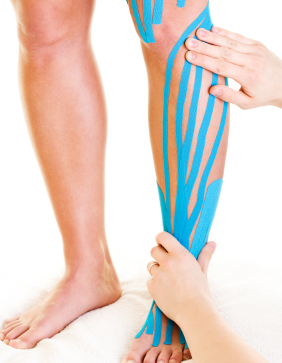
Kinesio taping uses a special designed tape that is applied to the body in ways that improve imbalances, protect muscles and improve performance. Even with proper physical therapy and massage, injuries take time to heal. During the healing process, sufferers can experience varying amounts of pain and limited movement. This makes working, training, and even regular exercise difficult or impossible sometimes.
Many athletes use various taping methods to support injured muscles and joints during rehabilitation. Taping varies both in method and effectiveness, but one specific method, Kinesio taping, is being heralded as a major leap forward.

What is Kinesio taping for injury?
Kinesio taping involves using a tape with unique characteristics in a very specific manner. Kinesio Tex is a hypoallergenic, latex-free, cotton fiber tape, with weight and thickness designed to be approximately the same as that of the skin. It is highly elastic despite its acrylic, heat-activated backing and can be stretched to around 60% of its resting length. While the tape itself has no medicinal properties, applied correctly by a trained therapist it has unique healing and stabilizing properties.
Once on the skin, the Kinesio tape creates additional space between the muscle and the dermis by pulling the upper layers of skin away from the muscle and relieving pressure on the lymph channels that sit in the area between the two. This allows better drainage of the lymph channels in the affected area. The increase in space also means that the nerve receptors housed in the affected areas are no longer compressed, and, therefore, the signals sent to the brain concerning touch and pressure on the receptors is changed. The brain no longer receives signals from the nerves suggesting that they are under constant pressure and no longer sends back signals to the body to respond to this pressure. In short, the nerves no longer feel under threat. In short, this allows the body to work more effectively and to stop wasting energy on a potential threat to its well-being.
Common injuries where Kinesio taping has been found effective are:
Kinesio taping for tennis elbow
Tape is applied to remove pressure on the elbow tendon and distribute the load across a larger surface area of the forearmm and upper arm.
Kinesio taping for shin splints
Kinesio taping the shin in a radial pattern to assist in supporting the muscles that attach to the tibia has been proven to be very helpful in reducing further trauma and in improving healing times. Also known as medial tibial stress syndrome, shin splints are commonly caused by repeated stress to the muscle surrounding the tibia.
Kinesio taping for shoulder impingement
The shoulder is an unstable joint by design and shoulder injuries are common. Kinesio taping shoulder injuries consists mainly of stabilizing the muscles of the rotator cuff to reduce strain on weakened or injured muscles until they are healed and/or strengthened.
Kinesio taping for knee pain
The knee is another common area for injuries. Kinesio taping the patella, hamstring or quadricep muscles to compensate for weakness, injury or structural imbalances can be a big help to athletes who are still trying to train and compete while enduring injuries.
Kinesio taping for back pain
Who hasn’t experienced back pain at one time or another? While the muscles of the back are large and powerful, they too can be overused and overloaded. Kinesio taping for back pain involves building a supporting structure for the back with tape that supports and stabilizes without restricting range of motion.
Additional benefits of Kinesio taping for athletes
As well as aiding in recovery from injury, Kinesio taping can potentially improve the performance of athletes. The space that is created between the muscle and the dermis allows more space for the muscles to move and contract, in turn allowing more fluid to be pushed through the muscles reducing muscle fatigue and increasing the range of motion achieved by the muscles.

Kinesio taping for injury prevention
The additional benefits do not stop with athletes. There is also growing evidence to suggest that the taping method can improve joint alignment by affecting the fascia, the web of connective tissue around the muscles, as well as the muscles themselves. Improved joint alignment from kinesio taping the area properly improves posture and minimizes the risk of further injury from any type of movement. Better alignment is also beneficial to an individual’s general health.
In addition to these health benefits, there is evidence to suggest that using the tape can have a positive effect on scar tissue on the skin. In a number of cases, individuals have experienced improved pliability of the skin and a reduction in contractures where the tape has been placed.
Kinesio taping for injury: finding qualified practitioners
Kinesio taping has to be completed in a specific way in order to be effective. Knowledge of how to apply the tape correctly involves training in the method and cannot be done by just anyone. While there is little risk of causing injury, incorrect placement of the tape will certainly not have the desired effects. If you are considering Kinesio taping as an alternative way of speeding recovery from injury, you should discuss it with your physiotherapist or massage therapist first.
Where can you find qualified providers of Kinesio taping? MassageBook is a directory of massage therapists and allows you to filter results by technique, including Kinesio taping for injury.
Updated September 4, 2015




